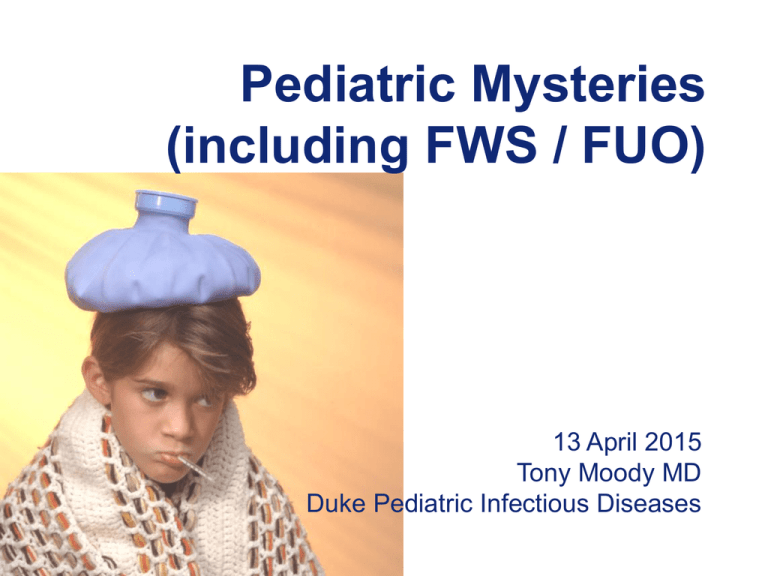FWS—Work-up
advertisement

Pediatric Mysteries (including FWS / FUO) 13 April 2015 Tony Moody MD Duke Pediatric Infectious Diseases What I will talk about ◦ Fever without source (FWS) ◦ Fever of unknown origin (FUO) ◦ Recurrent infections Case 1 10 yo ♀ with recurrent fevers to 102°F daily for six weeks ►also has generalized malaise ►unusual rash on legs ►good workup by PMD ►family worried Case 2 8 mo ♂ with third episode of pneumonia ►growth reasonable ►no FHx of recurrent illnesses ►CXR with multifocal infiltrates ►PMD worried Case 3 5 yo ♀ with daily fevers increasing in height for four weeks ►some cervical lymphadenopathy ►tired look ►initial lab work normal ►weight curve has flattened Commonalities in each case ► symptoms not explained by typical childhood illness patterns ► persistence beyond the norm ► “ain’t right” Definitions fever without source (FWS) fever of recent onset no adequate explanation based on history and physical exam Definitions fever without source (FWS) ≡ fever without localizing signs Definitions fever of unknown origin (FUO) fever of >7 days duration no diagnosis after initial work-up The Distinction FWS vs. FUO differential diagnoses different needs more immediate evaluation can take a more thoughtful approach FWS fever without source (FWS) fever of recent onset (<1 week) FWS fever without source (FWS) no adequate explanation based on history and physical exam (should be careful H+P) FWS—Epidemiology 5-10% (22%) of children with fever lack localizing signs peak incidence in 2nd year of life estimated a practicing pediatrician sees this once every 4-5 days FWS some are presenting with a new chronic illness some are gravely ill most are not FWS the evaluation is a bit like panning for gold… you must always pay attention! FUO FUOs are different you are out of the acute stage you have already done a work-up FUO two approaches to further work-up test for everything at once test in a stepwise fashion FUO—Epidemiology most have uncommon presentations of common illnesses case series— only 5 of 418 had rare disorder FUO—Epidemiology most series state that 10-20% of cases never get a diagnosis (50%) unlike adults, most children get better FUO in cases of FUO, three services are routinely consulted Infectious Diseases Rheumatology Hematology/Oncology Infectious Diseases Hematology/ Oncology Rheumatology FUO—Epidemiology most case series report that diagnoses are infectious > rheumatologic > oncologic FWS & FUO direct your work-up with two principles in mind 1. Look for things that are common. 2. Look for things that will kill you. FWS—Rational Work-up historically, two worrisome illnesses meningitis bacteremia and a third (UTI) that could be hard to diagnose Bacterial disease in FWS neonates (0-3 months) Streptococcus agalactiae Escherichia coli Listeria monocytogenes Bacterial disease in FWS infant / toddler (3 mos to 3 yrs) Haemophilus influenzae type B Streptococcus pneumoniae Neisseria meningitidus Bacterial disease in FWS children / adolescents (3-19+ yrs) Streptococcus pneumoniae Neisseria meningitidus Historical FWS historically, 3-5% of children with FWS had bacteremia and, 5-10% of those would develop meningitis if not treated Historical FWS historically, 3-5% of children with FWS had bacteremia plus, 10% would develop a localized infection Historical FWS historically, 3-5% of children with FWS had bacteremia and, 30% would have persistence of bacteremia Historical FWS historically, 3-5% of children with FWS had bacteremia overall badness rate of 1.4-2.5% Shifting FWS we now have excellent vaccine coverage against Haemophilus influenzae type B Streptococcus pneumoniae Current FWS now, <1% of children with FWS have bacteremia and, risk of complications lower badness rate <<1% FWS—Work-up after careful H+P for everyone blood culture, CBC/D FWS—Work-up after careful H+P for girls <2yo, boys <6mo (to 1yo if uncircumcised) urine culture, U/A FWS—Work-up after careful H+P if <3mo, if suspicion, if exposed CSF culture, CSF analysis FWS—Work-up after careful H+P consider a CXR FWS—Empirical Tx if work-up is unrevealing, consider antibiotic therapy FWS—Empirical Tx consider antibiotic therapy if unsure of follow-up unsure of reliability no relationship with family FWS—Antibiotics ceftriaxone and daily follow-up orals in select cases FUO—Rational Work-up patient should have already had blood culture, CBC/D urine culture, U/A CXR FUO—Rational Work-up what now makes the list of things that are common, or things that could kill you? FUO—Rational Work-up Rheumatology send ESR, CRP consider ANA unless obvious disease, I don’t push beyond this FUO—Rational Work-up Hematology/Oncology repeat CBC + manual differential send chemistries, including Ca and uric acid call H/O, discuss BM FUO—Rational Work-up Infectious Diseases serial blood cultures (endocarditis) place PPD (tuberculosis) send viral studies (sinus, pharynx, stool, urine) send complement (CH50) FUO—Rational Work-up Infectious Diseases, p2 consider imaging bone scan (osteomyelitis) MRI (bones, joints) CT (occult abscesses) FUO—Rational Work-up Infectious Diseases, p3 consider cardiology (Kawasaki) consider unusual cultures / tests Brucella, MOTT, Bartonella, Francisella, HACEK, Mycoplasma, etc. FUO—Rational Work-up Infectious Diseases, p4 every child getting an FUO w/u should get HIV testing!!! FUO—Rational Work-up Infectious Diseases, p5 never forget STIs send RPR, culture for GC, culture for Chlamydia FUO—Rational Work-up Infectious Diseases, p6 culture any site / fluid / tissue you can FUO—Further Work-up zebras are just that, uncommon don’t send tests for unusual genetic disorders unless the history dictates it FUO—Empirical Tx in general, NONE FUO—Empirical Tx we know that 1. most children will get better 2. most children have common illnesses 3. it hasn’t killed them yet! FUO—Empirical Tx giving antibiotics to a child with FUO, especially after it has been going on for a while, is like shooting a gun into a dark room (please just send them to ID clinic) Finally… when is it too much? my kid has a cold constantly… my kid has had three pneumonias this year… my kid has had pneumonia and meningitis and a joint infection… Immune Deficiency these are uncommon, but you will see them never forget HIV!!! and consider SCID, CGD, diGeorge, etc. Immune Deficiency context is everything daycare? playmates? family history? siblings? underlying disorders? past history? Finally… when is it too much? my kid has a cold constantly… (probably daycare) Finally… when is it too much? my kid has had three pneumonias this year… (worrisome, asthma?) Finally… when is it too much? my kid has had pneumonia and meningitis and a joint infection… (ain’t right) Case 1 10 yo ♀ with recurrent fevers to 102°F daily for six weeks ►also has generalized malaise ►unusual rash on legs ►good workup by PMD ►family worried Case 2 8 mo ♂ with third episode of pneumonia ►growth reasonable ►no FHx of recurrent illnesses ►CXR with multifocal infiltrates ►PMD worried Case 3 5 yo ♀ with daily fevers increasing in height for four weeks ►some cervical lymphadenopathy ►tired look ►initial lab work normal ►weight curve has flattened Final Word Please call. Seriously. We love this stuff. Fellow pager 970-7420 (24-7-365) consults / questions ID Emergencies in Pediatrics 13 April 2015 Tony Moody MD Duke Pediatric Infectious Diseases Goals ◦ discuss infections that can kill or maim without prompt attention ◦ outline presentation, labs needed, interventions needed Case 1 You are in the ED on Wednesday, near the end of your shift. You are asked to eyeball an 11 mo ♂ with decreased feeding and urination, fever and lethargy, all with sudden onset. On exam you see a rash on with small, non-blanching, red macules with dark centers. Case 1 Your next action for this patient should be A. diagnose a viral illness and discharge B. obtain a blood culture C. perform a lumbar puncture D. administer ceftriaxone IM. Case 1½ Children in his daycare room should A. receive routine care B. receive vaccination against pneumococcus C. receive rifampin prophylaxis D. have lumbar punctures performed. Case 2 On Thursday, you see a 6yo ♀ with 3 days of fever & sore throat. Her mother reports a red, raised rash. You find HR 120, T 39. Her L leg below the knee is swollen. She is crying and inconsolable. Case 2 Your next action for this patient should be A. LA Bicillin for strep throat B. start oral penicillin C. start IV penicillin and clindamycin D. call for a surgical consult. Case 3 On Friday, you see a 20mo ♀ with a 2 day history of fever & fussiness. Her mother notes the child is refusing to walk and is fussy with diaper changes. You see a child with T 38.5 and holding her R leg flexed and externally rotated. Case 3 Your next action for this patient should be A. call for an orthopedic consult B. call radiology for a hip ultrasound C. start meropenem D. diagnose toxic synovitis and discharge on NSAIDs. Case 4 On Sunday, you see a 5yo ♂ with 3-4 days of congestion / rhinorrhea. This morning his mother noted the acute onset of R eye swelling. On exam you see tense edema of the eyelid with proptosis, lateral gaze paralysis, conjunctival injection. Case 4 Your next action for this patient should be A. IVIG infusion B. Call ENT / Ophtho C. start 3rd generation cephalosporin D. thyroid studies. Case 5 On Monday, you see a 2yo ♂ whose family are recovering from a “flulike” illness. He had been recovering until this morning when he developed a distressed look and high fever. On exam he has inspiratory stridor, retractions, and a normal O2 saturation. Case 5 Your next action for this patient should be A. Immediate intubation B. CXR C. Chest CT D. administer nebulized albuterol. Case 5½ The CXR is shows no foreign body, little parenchymal disease. Now A. Immediate intubation B. start vancomycin C. Chest CT D. administer nebulized albuterol. Case 6 In 1985, you see a 3yo ♀ who had mild fever and cough followed by the sudden onset of respiratory distress and irritability. She is hoarse, sitting in mother’s lap, leaning forward, drooling, and has retractions. Case 6 Your next action for this patient should be A. Immediate intubation by the intern B. CXR C. immediate intubation by an anesthesiologist D. start an IV for antibiotics.








